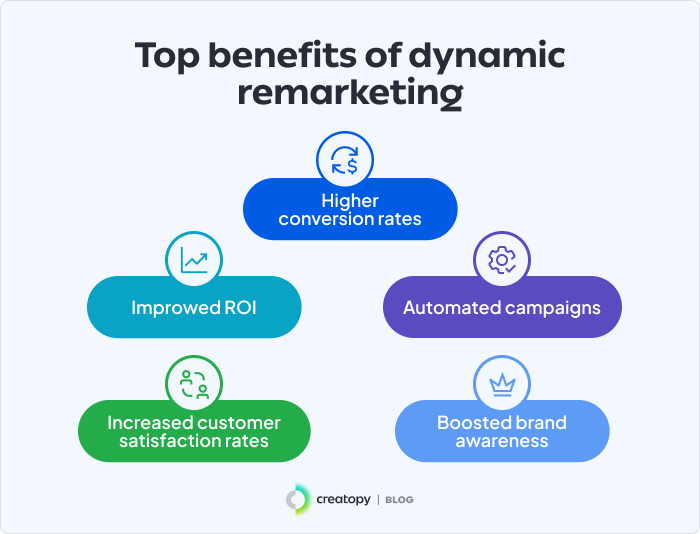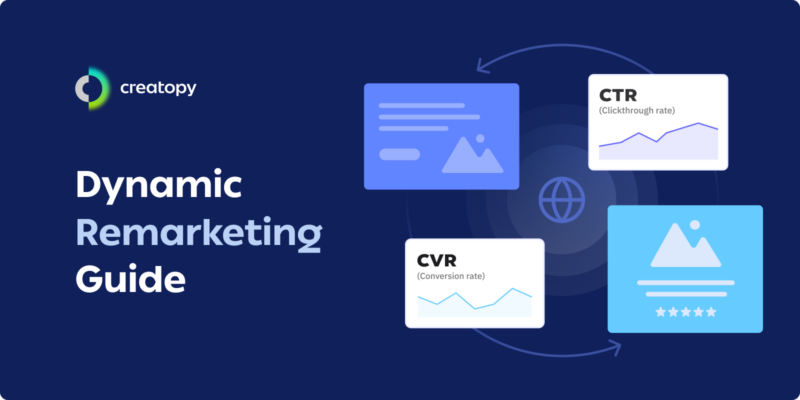Dynamic remarketing can revolutionize your marketing strategy. Unlike traditional remarketing, which shows generic ads to users who have visited a site, dynamic remarketing uses data about the specific products or services the users viewed or engaged with. Leveraging this data empowers B2B companies to increase brand awareness, improve customer satisfaction, and boost conversion rates—all while saving time, money, and hassle.
Not sure how to implement dynamic remarketing or how it will impact your business? We’ve put together this guide to help you understand how dynamic remarketing works, what benefits it brings, and how to get started—let’s dive in!
What is remarketing?
Remarketing—sometimes called retargeting—is a marketing tactic that involves serving ads to people who have already viewed or interacted with your website. This allows you to re-engage users who have previously shown interest in your website, app, or social media but didn’t complete the desired action. This could be purchasing a product, signing up to a newsletter, or filling out a form.
What is the difference between standard remarketing and dynamic remarketing?
Standard remarketing simply uses the information that someone has visited your website to show them generic ads. Leveraging cookies and advanced tracking tools, the technology recognizes the visitor and uses ads to attract them back to the website, nurture leads, and increase conversions.
Dynamic remarketing takes this process a step further. By tracking a user’s behavior and interactions, businesses can turn these customer insights into effective marketing strategies. For example, this data can tell you which products they viewed or added to their basket. You can then set up personalized ads for that individual, featuring the products or services they previously viewed.
How dynamic remarketing works
Dynamic remarketing employs advanced tracking and data collection mechanisms to create highly targeted advertising campaigns. Here’s a step-by-step breakdown of how it operates:
- User interaction tracking
When a user visits your website, tracking codes (often using cookies) monitor their behavior. This includes pages they visit, products they view, items they add to their cart, and any actions they take on your site.
- Data collection
The tracking code collects and stores this data, creating a detailed profile of the user’s interests and interactions. This data is usually stored in a centralized database, which can be accessed for ad personalization.
- Product feed integration
Your website’s product or service catalog is integrated into your dynamic remarketing setup. This feed contains all necessary details about each item, such as images, prices, descriptions, and availability.
- Ad creation
Using the data collected about user behavior, dynamic remarketing platforms automatically generate personalized ads. These ads feature the exact products or services the user interacted with, along with relevant information pulled from the product feed.
- Targeted ad display
The personalized ads are displayed to the user across various websites and platforms within the ad network you’re using. This can include Google Display Network, Facebook, and other third-party ad networks.
- Ad optimization
Over time, the dynamic remarketing system optimizes ad performance by analyzing user responses and adjusting ad content, timing, and targeting strategies to improve engagement and conversion rates.

What are the benefits of dynamic remarketing?
Still not sold? Let’s take a deeper look at the benefits of dynamic remarketing and how it can improve your business outcomes.
Higher conversion rates
Dynamic remarketing significantly boosts conversion rates by displaying ads tailored to individual users based on their previous interactions with your website. When users see personalized ads featuring products they’ve already shown interest in, they’re more likely to return and make a purchase. This targeted approach ensures your marketing efforts are relevant to the audience, turning potential customers into buyers.
This acts as powerful marketing collateral, reinforcing brand messaging and increasing the effectiveness of your overall marketing strategy.
Improved ROI
With dynamic remarketing, your advertising spend becomes more efficient and effective. Targeting users who have already demonstrated an interest in your products or services means you are more likely to achieve conversions with fewer ad impressions. This precision targeting leads to a higher return on investment, as your budget is directed towards an engaged audience that is already warmed up to your brand.
Automated campaigns
Dynamic remarketing systems automate the creation and optimization of ads. This saves you a significant amount of time and effort, and makes it easy to scale your campaigns, even for large product catalogs.
Automation is a game changer for marketing. Over 91% of marketers say automation helps them achieve their objectives, and it’s clear to see why. From reduced costs and higher productivity to increased ROI and customer satisfaction, automated technology like virtual agents, email platforms, client onboarding software, and social media tools are an absolute must for businesses who want to get ahead of the competition.
Increased customer satisfaction rates
When customers see ads that are relevant to their interests and needs, their satisfaction with your brand increases. Dynamic remarketing ensures that your advertising efforts are not only effective but also considerate of the user’s journey. By delivering personalized and timely ads, such as pushing your logo maker software to people looking into starting a new business, you enhance the overall customer experience, fostering loyalty and encouraging repeat business.
Boosted brand awareness
Most customers aren’t ready to make a purchase when they first visit your website or look at your products. The most successful businesses understand that you can’t always immediately convert a customer, but you can make sure you’re the first place they go to when they reach that stage of their buyer journey.
Maintaining a presence across ad platforms will help keep your company top of mind, especially if you are using dynamic remarketing to show the most relevant ads to your customers. This increased brand awareness will ensure that as soon as that customer is ready to make a purchase, there will only be one name on their mind.

Examples of dynamic remarketing for B2B marketers
Now you have an overview of the advantages of dynamic marketing, you’re probably wondering how it works in practice. The examples below will give you a better idea of how you could implement dynamic remarketing in your business, and what results you can expect.
1. Software as a Service (SaaS) solutions
Imagine you run a B2B SaaS company offering contact management software. A potential client visits your website and checks out the features of your software, such as phone forwarding, watches a demo video, or explores an interactive demo but leaves without signing up for a trial.
With dynamic remarketing, you can display personalized ads to this potential client as they browse other websites. These ads can highlight the specific features they viewed, offer a special trial promotion, or share customer success stories. This targeted approach reminds them of the value your software can bring to their business and encourages them to take the next step.
2. Business consulting services
Say your consulting firm offers specialized services to improve operational efficiency for businesses. A company executive visits your site, reads about your process optimization services and downloads a whitepaper, but doesn’t schedule a consultation. With dynamic remarketing, you can serve ads to this executive that emphasize the benefits of your consulting services, showcase case studies of past successful projects, or offer a free initial consultation. These personalized ads keep your firm top of mind and make it easier for the executive to decide to reach out and engage your services.
In each of these examples, dynamic remarketing uses the specific actions and interests of potential clients to create tailored ads that keep your business in their consideration, nudging them towards making a purchase or inquiry.
How to set up dynamic remarketing
Setting up dynamic remarketing involves a few key steps to ensure you can display personalized ads to users based on their interactions with your website. Here’s a simple guide to get you started:
Step 1: Create a product or service feed
Compile a list of all the products or services you offer, including details like names, descriptions, prices, and images. This feed will be used to generate personalized ads.
Step 2: Add a remarketing tag to your website
Place a small piece of code, called a remarketing tag, on your website. This tag collects data on user behavior, such as the pages they visit and the products they view.
Step 3: Link your feed to your ad platform
Connect your product or service feed to your advertising platform, like Google Ads or Facebook Ads. This integration allows the platform to dynamically create ads based on the feed and user interactions.
Step 4: Create dynamic ads
Use your ad platform to design dynamic banner ad templates. These templates will automatically populate with information from your product feed, creating personalized ads for each user. Be sure to include a call to action to increase conversions, like a website link or voice over IP phone number.
Step 5: Set up remarketing campaigns
In your ad platform, create a new remarketing campaign and select the audience you want to target. This audience will be defined by the data collected from the remarketing tag on your website.
Step 6: Customize your targeting and bidding
Utilize customer segmentation to adjust your targeting settings, reaching precise audience segments such as users who viewed specific products or abandoned their shopping carts. Set your bidding strategy to control how much you’re willing to pay for each ad click or impression.
Step 7: Launch and monitor your campaign
Launch your dynamic remarketing campaign and monitor its performance regularly. Use the data and insights from the campaign to optimize your ads, targeting, and bidding for better results.
Conclusion
Dynamic remarketing is a game-changer for your marketing strategy, delivering personalized ads that truly connect with your audience. By leveraging detailed user data, you can craft highly targeted campaigns that drive conversions, boost brand awareness, and enhance customer satisfaction.
Ready to take your marketing to the next level? Follow our guide and start reaping the benefits of dynamic remarketing today.








